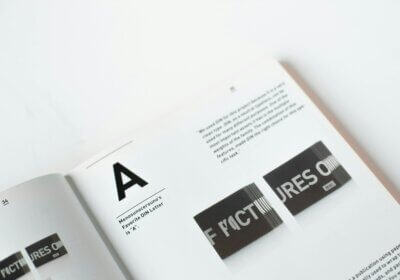It’s nearly impossible to exaggerate the importance of fonts in today’s visually driven society, as businesses compete for consumers’ attention in a noisy marketplace. A well-chosen typeface has the power to make people feel something, gain their trust, and establish a distinct identity for a brand. Every font has the ability to convey a distinct personality and idea, whether it’s the timeless grace of serif fonts or the sleek simplicity of sans-serif fonts. An eye-catching font can do wonders for a brand’s visual appeal, legibility, and impact. What separates a generic design from an engaging brand experience is each little detail.
This all-inclusive guide will take you on a tour of typography, explaining everything from the basics of fonts to how to pick the best one for your brand’s identity. Learn the ins and outs of font psychology, identify the most important considerations, and get some useful pointers to help you make a good choice. You will come away from this tutorial with a better grasp of the power of typefaces to communicate your brand’s narrative and make an impression on your target demographic.
Understanding the psychology of fonts
It’s crucial to understand the psychological effects of typography before moving on to the more technical parts of font choosing. Just like words, fonts may make people think of certain things or feel certain ways. Every font has its own distinct personality that can impact how people see things and what they do.
Many people think of serif fonts as being traditional, formal, and sophisticated because of their graceful flourishes and historical heritage. They have the power to awaken feelings of reliability, agelessness, and tradition. The contrast is with sans-serif fonts, which are seen as contemporary, friendly, and practical due to their spare design and clean feel. You may use them for a variety of brands, from software startups to creative agencies, because of how versatile they are.
Elegant, romantic, and expressive are some of the feelings that are generated by script fonts due to their handwritten look and graceful curves. They work wonderfully for feminine, artistic, or opulent brands. Use beautiful, bold display typefaces to make eye-catching headlines, logos, and other unique components. Nevertheless, it is recommended to utilize them sparingly so as not to overpower the design.
Key factors to consider when choosing a font
Your brand’s visual identity is heavily influenced by the font choice you use. Here are some important aspects to keep in mind when making your choices:
Your brand’s individuality should shine through in the font you use. Serif fonts with a more classic style may be chosen by more traditional firms, while sans-serif fonts with more modern lines may be preferred by more contemporary brands. To show their individuality and artistic side, creative brands might play around with display and script fonts. For a more serious vibe, go with a serif or sans-serif typeface; for a more playful vibe, go with a display font or rounded sans-serif.
Your brand’s ideals should inform your choice of font as well. Serif typefaces with an antique appearance transmit reliability, while sans-serif fonts with an air of modernity portray innovation. Script typefaces with graceful curves are a common choice for high-end firms, while sans-serif fonts with straight lines are more common for minimalist brands. Brands that are lighthearted and carefree can use display typefaces with playful graphics.
When choosing the font you use, it is essential to keep your intended audience in mind. For example, sans-serif or display fonts with more contemporary or witty styles may be more appealing to younger groups than older ones, who may lean more toward conventional serif fonts. Fonts having distinctive features, such as script or display, may appeal to creative audiences more than more formal serif or sans-serif fonts.
Make sure your message is easy to understand by prioritizing readability. From headlines to body information, choose a legible font size across all sizes. Make sure the font weight is comfortable on the eyes by staying away from thin or extremely aggressive fonts. For best reading and aesthetics, play around with the line height and letter spacing.
Stay true to your brand’s identity by using the same fonts and color scheme in all of your marketing materials. Create a style manual to keep the visual identity of your brand consistent. You can choose a typeface that speaks to your brand’s ideals, personality, and intended consumers by thinking about these things.
Tips for Choosing the Perfect Font
Learn the psychological effects of various font types by experimenting with them. Keep your font choices to a minimum of two or three to keep everything looking organized. Try out various font combinations in prototypes and mockups to see which ones work best together. Think about whether your design will be seen in print, on the web, or on a mobile device, and pick fonts accordingly. To gather useful ideas, ask your coworkers, clients, or target audience for input. Lastly, don’t be scared to try out various combinations in order to find fresh and original answers.
Avoid these frequent font errors
Although taking risks is highly encouraged, it is critical to stay clear of typical mistakes that might destroy your design. If you use too many fonts, it will compromise your brand’s message and make the design look chaotic. Avoid using aesthetically pleasing fonts if you prioritize comprehension above everything else. Create a visual structure and direct the reader’s eye with a variety of font sizes and styles. Make sure the fonts you choose go well together; that way your design will be more balanced and attractive. And lastly, to stay clear of copyright violations, make sure to utilize officially licensed fonts if you’re doing business.
Need help finding your ideal font buddy for your business? Google Fonts is the default in most matching instructions, but what if the font you really want isn’t free? Use WhatFontIs.com to find the name of any typeface you come across online, whether it’s free or paid! With this helpful tool, you’ll be able to decipher the code and achieve font perfection.



